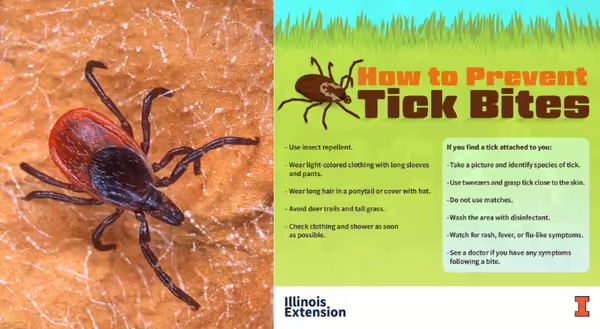
Summer is officially here, and it’s time to get out to your favorite walking or hiking spot! That may entail walking through tall grass and woodland brush, depending on where you go. Protect yourself from Lyme disease and Rocky Mountain fever by following tick prevention advice of forest enthusiasts and agricultural professionals.
If a tick gets past your preventative methods, take an image of it so that you can identify it and know your disease risks. Although it is important to keep yourself safe, ticks should not keep you from your usual summer activities.
One of the most common ticks of concern is the black-legged or deer tick. They can transmit Lyme disease to humans. These ticks are most common in wooded areas and along trails with high densities of brush. They are about 1/4” across, so be sure to look closely at your clothes and exposed skin after hikes.
Tick prevention steps when visiting tall grassy or wooded areas, middle of prairies, wetlands, deer trails, off-trail, and brushy areas are as follows:
- Local Foods/Small Farms Educator Nick Frillman says to use the buddy system and conduct mutual visual inspections of clothes, hairlines, etc between friends, family, or colleagues after hikes wear light-colored clothing so ticks are easy to see.
- Use an insect repellent containing DEET or Picaridin to all exposed skin.
- Wear long pants and long-sleeve shirts; always wear a belt, a tight undershirt (yoga top), or tuck pant legs into boots so ticks will not crawl up into these places.
- Forest ecologist Cassandra Allsup always wears her hair back in a braided ponytail or hat as most of the ticks she finds are in her hair. She always brushes her hair before getting back into the car.
- Permethrin creates a symptom called “hot foot” in ticks; when they climb onto the fabric the tick cannot stand to be on the clothing anymore and will fall off. Master Naturalist, Vickie Hansen, says “I’ve been using permethrin for a couple of years with amazing results. It is a product that you spray on your clothing, gear, even tents, and it repels ticks, mosquitoes, and chiggers. It is not intended to be sprayed on your skin. My husband and I wore clothing treated with permethrin to hike at Voyageurs National Park and neither of us found any ticks on us.”
Tick Removal:
- Remove ticks in the first 24-36 hours to prevent disease transmission, and photograph it.
- Use tweezers to grasp the tick close to the skin. If tweezers are not available, use a piece of cloth.
- Wash the area with disinfectant.
- Shower immediately when you get home, and methodically look through hair; be sure children do too.
- Follow up with a physician if symptoms of tickborne disease occur.
RESOURCES: I-Tick
PHOTO CREDIT: Blacklegged Tick Photo by Scott Bauer, USDA Agricultural Research Service, Bugwood
Graphic Universty of Illinois Extension
ABOUT THE AUTHOR: Kelly Allsup is a Horticulture Educator for University of Illinois Extension serving Livingston, McLean and Woodford Counties. She meets the educational needs of her community, including local chapters of Master Gardener and Master Naturalist volunteers, through expertise in home horticulture and entomology. Her passion for ecologically-friendly gardening and all things plants makes her a dynamic speaker on topics that range from beneficial insects, growing vegetables and fruits, to urban trees.